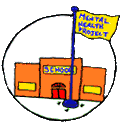

Ideas into Practice
As families move more frequently, schools are finding more students coming and going all year long. Mobility and transiency can be as high as 50- 60% over a year in schools serving large numbers of low income families.
Not surprisingly, reports from the field indicate that many students have a difficult time fitting in at a new school. Some come with a sense of alienation and sometimes with a chip on their shoulder.
Newcomer problems are among the litany of things schools cite as major barriers to student progress. And, of course, any mental health professional will agree that difficult transitions can produce emotional, behavioral, and learning problems.
Some mental health professionals are beginning to design programs to address this source of problems. Drawing on knowledge of social support, they are designing programs to help students and their families make the transition into a new school and community.
Major features of the programs include:
Welcoming strategies (e.g., recruiting volunteers to greet newcomers at the school house door; training and equipping front office staff so they can provide a sense of welcome; training teachers to establish classroom welcoming strategies -- especially peer buddies who have been prepared to carry out the functions of host and guide during the newcomers first weeks; establishing a "parents welcoming parents" committee)Social support strategies (e.g., training teachers and the parent welcoming committee to connect newcomers with ongoing groups and activities; providing support groups for those having trouble connecting with others)
Initial reports indicate the programs not only facilitate student and family transition into a school, they may also reduce transiency. Families who feel connected to a school may make an extra effort not to move or at least to stay in the neighborhood.
Contact our Clearinghouse for more on this.
Also from the Newsletter: Demonstrating the Ideas
As part of the New American School Development Corporation's "break-the-mold" initiative, an approach called the Learning Center Model is being evolved. The model's design calls for transforming schools into high performance learning and family- serving communities. To do so, the resources of school, home, and community are used to evolve three complementary components: (1) instruction/ learning, (2) enabling, and (3) management and governance.
The design weaves programs and services for addressing barriers to student learning into a school's fabric. In doing so, it clarifies why a school must, and demonstrates how it can, go beyond the constraints of the school-linked, integrated services model through developing an enabling component.
Commitment to all children succeeding is viewed as requiring that a school evolve a comprehensive, integrated continuum of enabling activity aimed at helping as many students as feasible. This includes the type of integrated health and social services described in the full service school model -- and much more. That is, the activity not only addresses personal problems experienced by students and their families, but a full range of factors seen as causing poor academic performance, dropping out, gang violence, teen pregnancy, substance abuse, racial conflict, and so forth. This translates into the need to evolve a continuum of programs (from primary prevention to treatment of chronic problems) and a continuum of interveners, advocates, and sources of support (e.g., peers, parents, volunteers, staff, professionals-in-training, and professionals).
To these ends, besides health and human services, broad-based programmatic efforts are generated to address barriers to learning and teaching -- as well as to promote healthy development and foster positive functioning as the best way to prevent many learning, behavior, emotional, and health problems and as a necessary adjunct to corrective interventions. One example is an evolving focus on prereferral classroom strategies to reduce the numerous mild-to-moderate learning and behavior problems sent for special services. Another is creation of welcoming and social support
interventions to facilitate a positive and rapid transition of new students and their families into school and community life.
To minimize fragmentation and encourage cross disciplinary functioning, intervention activity is clustered into the following six interrelated areas
This programmatic framework guides planning, implementation, evaluation, and personnel development. An Enabling Component Coordinating Team works to ensure cohesiveness of school- community-home intervention, enhancement of resources, and integration of the enabling, instructional, and management components.
As developed at one site, a Family Resource Center facility (encompassing a medial clinic and mental health counseling) is used as the focal point and hub for enabling component operations. The site also is beginning to explore integrated use of advanced technology (e.g., a computerized system to organize information, aid case management, and link students and families to referrals).
|
School Mental Health Project-UCLA WebMaster: Perry Nelson (smhp@ucla.edu) |
 |